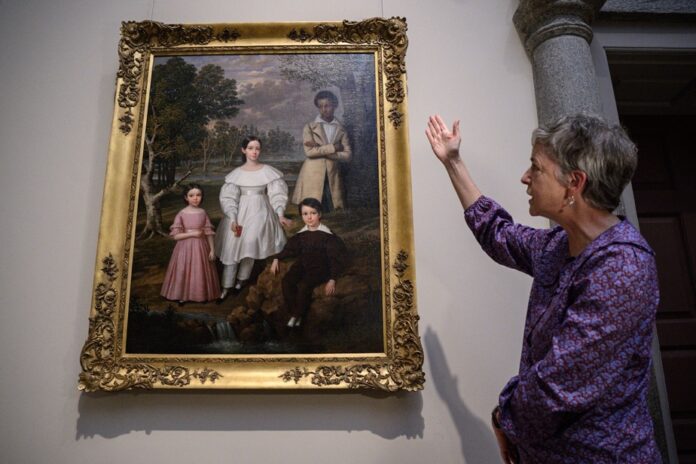(New York) For a long time, the three children of a wealthy home in New Orleans seemed the only characters in a forgotten painting, attributed to the Frenchman Jacques Amans. The family slave, Bélizaire, had been erased from the painting, now hanging in the prestigious Metropolitan Museum in New York.
For the large museum that borders Central Park in Manhattan, it is “the first naturalistic representation of a named enslaved person in the South” of the United States, where slavery was officially abolished in 1865, points out the curator of the Met’s wing devoted to American art, Sylvia Yount.
“We don’t have any other work like it in the collection and that allows us to tell a lot of different, interesting and complex stories,” she adds, in front of the painting, an oil on canvas from 1837, on display at the public since Thursday.
However, the figure in the background of the young servant, who stands straight, arms crossed and gaze deep, almost disappeared forever from the painting commissioned by the father of the family, Frederick Frey, a banker by origin German based in New Orleans.
Without knowing the exact reason, and probably at the beginning of the 20th century, when the Frey couple had died and the painting passed into the hands of heirs, the mixed-race teenager was obscured by repainting.
“The family may not have been proud of having a slave in a painting, because it meant being seen as a slave-holding family. The other hypothesis is that they didn’t want a black character next to their white ancestors,” supposes Sylvia Yount.
The painting landed in the collections of the New Orleans art museum in 1972, where it languished for more than 30 years in storage, before being sold in 2004. It was not until 2005 that it was restored, the initiative of a new owner, and the figure of the young servant reappears.
But it is thanks to a collector from Baton Rouge in Louisiana, Jeremy K. Simien, passionate about the representations of Creoles and Afro-Creoles in the art of his region that the painting emerges from anonymity. He first discovered the restored work on an auction site, then, while searching the sales history, its truncated version sold by the New Orleans museum.
“I could see the image through it, I could see the edges […] it really impressed me,” he says.
The collector eventually acquired the painting in 2021. He hired a specialist historian, Katy Shannon, who searched Louisiana archives to discover that the young servant painted on the work was named Bélizaire, and that it was sold to 6 years old in 1828, with his mother, to the Frey family.
Of the three Frey children, two died the year the painting was painted, and the third a few years later. Bélizaire, the only survivor of the painting, was later sold to a sugar cane plantation, but according to historical research, he experienced the end of slavery.
“In a way, it serves as a representation of a lot of history that has been erased or replaced. And I’m very happy that they understood that at the Metropolitan Museum, which acquired the painting, he adds. The terms of the transaction between the collector and the museum remained confidential.
At the Met, the work is presented with its history and a photo of its version without Bélizaire.
“We need to tell these more complicated stories,” says Sylvia Yount.















